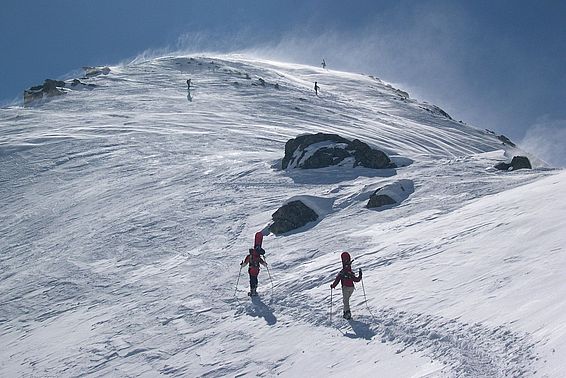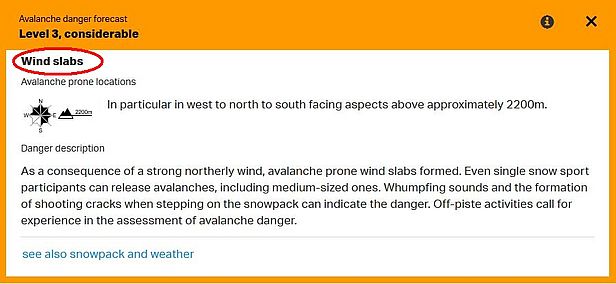19.12.2019 | Benjamin Zweifel, Claudia Hoffmann | News SLF
Starting this winter, the avalanche bulletin will highlight the most significant avalanche problem.
The danger description that forms part of the avalanche bulletin also points out the typical avalanche problems. While the indication of the avalanche danger provides an answer to the question “How great is the danger?”, the naming of the avalanche problem answers the question “What is the problem?”. In 2017, the European Avalanche Warning Services defined the following five types of snow that characterise avalanche problems:
Until now, however, there has been a lack of clear criteria for assessing when the individual avalanche problems are to be named in the avalanche bulletin. In consequence, multiple problems have often been described in the bulletin – sometimes over an extensive period. The intended purpose of pointing out the avalanche problems, namely to help users to focus on the key issues, was therefore not fulfilled. In view of its desire to use the defined terms more concisely, the SLF has now defined new clear criteria.
The new policy is as follows: ¶
-
Focus on the most significant avalanche problem:
In many cases in the past, the avalanche bulletin mentioned multiple avalanche problems at the same time. Now, as a general rule, only the most significant avalanche problem is to be named in the title (see illustration). If additional avalanche problems exist, they will still be described in the text but no longer named in the title. Multiple problems can be named in the title only if they are similarly striking.
-
Limited mention of the problem “old snow”:
In future, the avalanche problem “old snow” is to be named only if distinct weak layers exist inside the old snowpack and a snow sport participant is capable of fracturing these layers and thus releasing an avalanche. Fractures in an old snowpack can give rise to particularly large and therefore especially dangerous avalanches. In situations in which the old snowpack contains relatively weak layers in which fracture initiation and propagation is unlikely to occur, the avalanche problem “old snow” is no longer to be named.
-
New phrase “no distinct avalanche problem”:
If there is no new fallen snow, the wind slabs are more than about three days old and unlikely to be released, and no conspicuous weak layers exist – a situation that has mostly been described to date as an old snow problem – the phrase “no distinct avalanche problem” is to be used in future.
-
Distinction between new snow and wind slabs:
The avalanche problems “new snow” and “wind slabs” are to be more clearly differentiated in future. In cases of significant snowfall, the familiar phrase “new snow and wind slabs” (sometimes “fresh snow and snow drift accumulations”) is to be replaced by simply “new snow”.
Although wind is seldom absent when snow falls, so that wind slabs are usually formed as well, the main danger arises from the additional load applied by the new snow. Another typical characteristic of the avalanche problem “new snow” is the existence of avalanche prone locations over a wide area. In the case of the avalanche problem “wind slabs”, in contrast, the avalanche prone locations are more localised and most often easier to recognise. In future, the avalanche problem “wind slabs” is to be named only when the primary cause of danger is the transportation of snow by the wind.
It is important to note that the changes relate only to the stating of the avalanche problems in the avalanche bulletin. The definitions of the avalanche problems themselves remains unchanged.
Contact ¶
Copyright ¶
WSL and SLF provide image and sound material free of charge for use in the context of press contributions in connection with this media release. The transfer of this material to image, sound and/or video databases and the sale of the material by third parties are not permitted.

